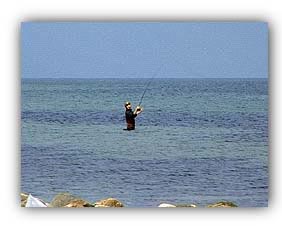"Points" are generally good landmarks to use as a base for the fishing. Not that there are necessarily more fish there, but as they make good mental holding points. Points are good spots to start fishing and from these landmarks you can make 'excursions'
Use landmarks
"Points" are generally good landmarks to use as a base for the fishing. Not that there are necessarily more fish there, but as they make good mental holding points. Points are good spots to start fishing and from these landmarks you can make 'excursions'.
Take your time
Take your time. Like on a stream, the first minutes without casts is a good investment. If there are fish you will almost always see surface action. You might see subsurface structures of interest. In harder weather you're likely to see waves breaking over obstacles under the surface indicating the character of the bottom.

Stand on the sand - fish over the weed... if possible
Fish are jumping...
It is very likely that you see fish out of the water. Sea trout will often leap completely out of the water and even more often you'll see baitfish escaping indicating action under the surface. Also the behaviour of gulls, camorants and other birds will tell you a lot about the life under water.
And don't be intimidated by seals or porpoises. These mammals are fairly common in Denmark, but unless they are swimming very close to you or the shore, they won't interfere with the fishing. Stop fishing if they come too close (especially seals are very courious). You wouldn't want to hook one on a big streamer.
Don't wade into it!
And... if you see a good spot, don't wade into it! Always fish the shallows (knee deep) water from the beach or with the water just over your boots. Then you can wade deeper, but still not walk into the spot! Keep next to the place where you expect the fish to be, stay on the sandy spots (if any) or gravel and fish over the darker, deeper spots with sea weed. These are the holding 'lies' of the ocean. And always fish short casts first and then further out. Long casts will often result in fish that jump where the line lands. Right in front of you.
Fish with variation
Fish your fly with variation. This is the one most important tactic. Don't start changing your fly endlessly unless you get clear refusals from seen fish. Change change tactics in stead. Fish differently, from other places, retrieve faster or slower. Fish dead drift in currents. Fish deep and high - even letting the fly dwell on the bottom or break the surface.
Don't change flies
Selecting a fly isn't that difficult. I use a lot of naturally colored flies with orange and purple winter flies as an exception. The flies are typically large in the winter and spring, and smaller in the autumn. This follows the eating pattern of the sea trout which will eat larger baitfish and fry in the spring and small fish and crustaceans in the fall.
On the fly page there will be indications of the season in which the patterns used, but any of my trusty patterns can catch fish in any season. Often water conditions will be more important than season.
- Log in to post comments







